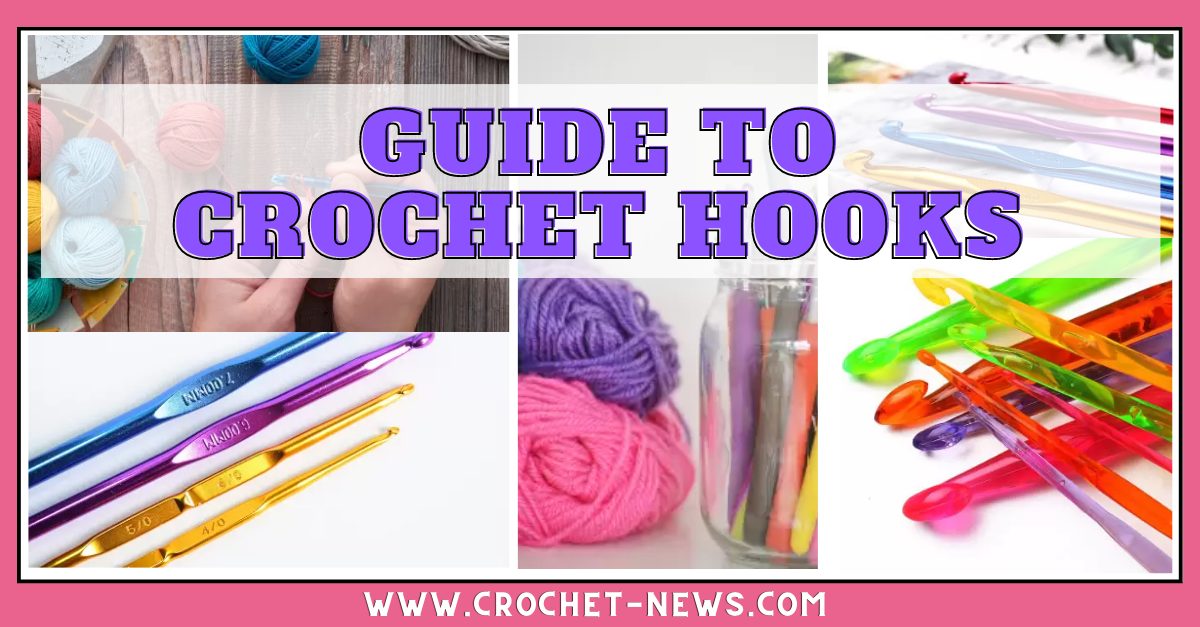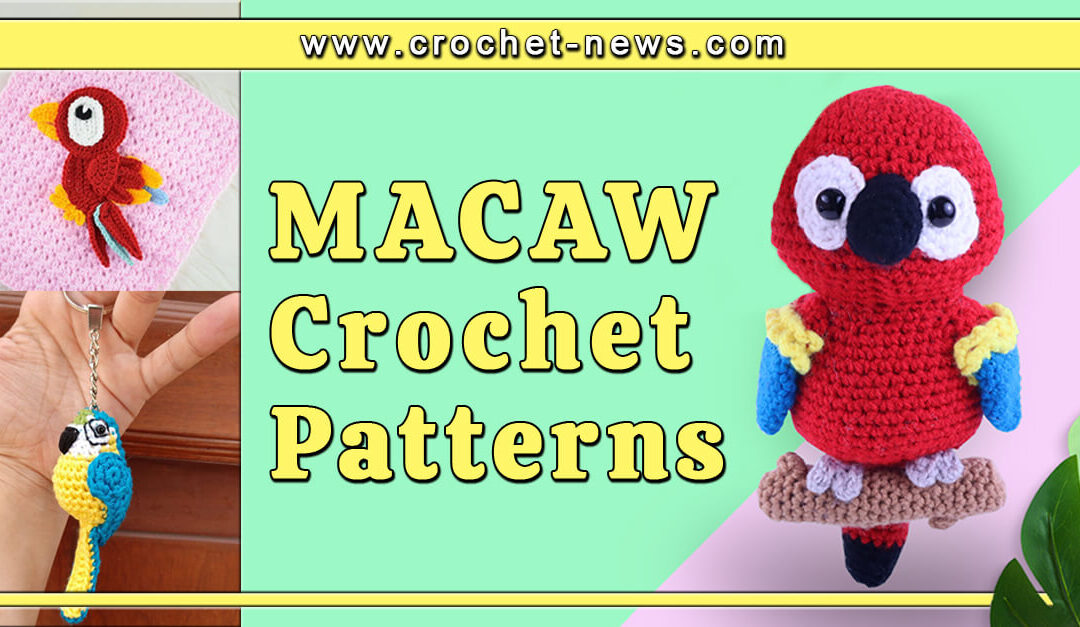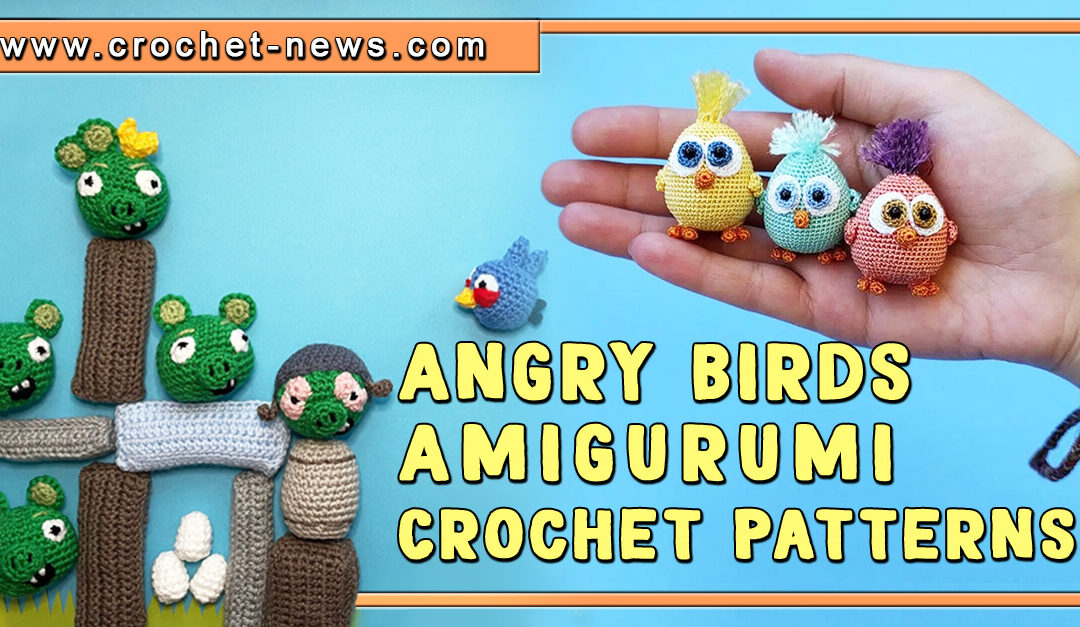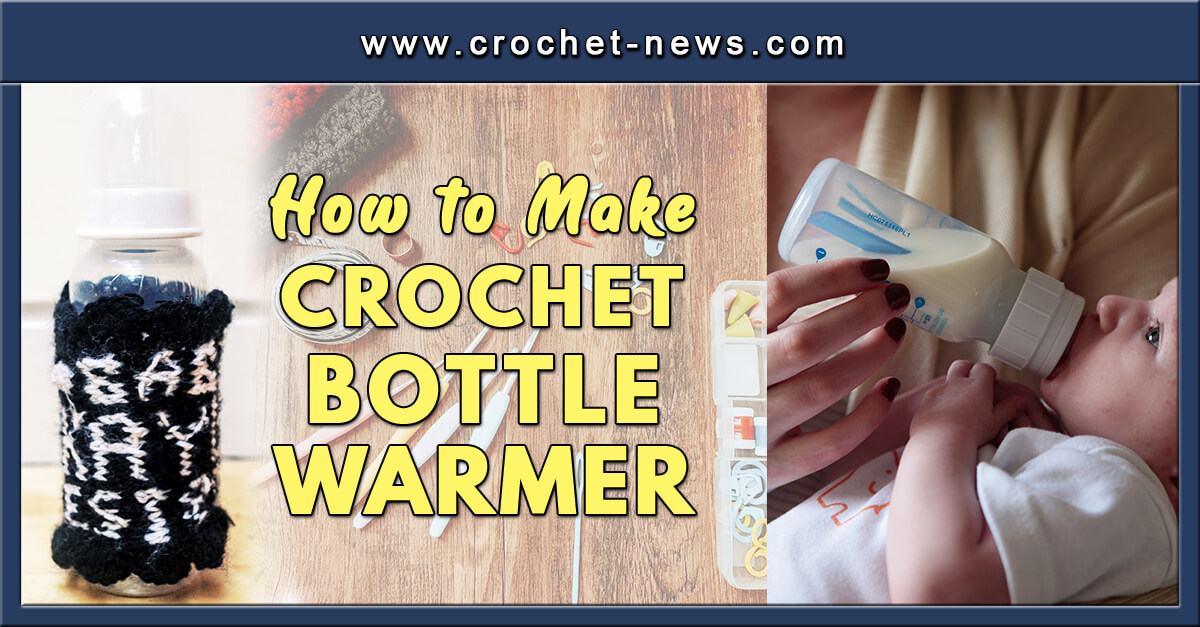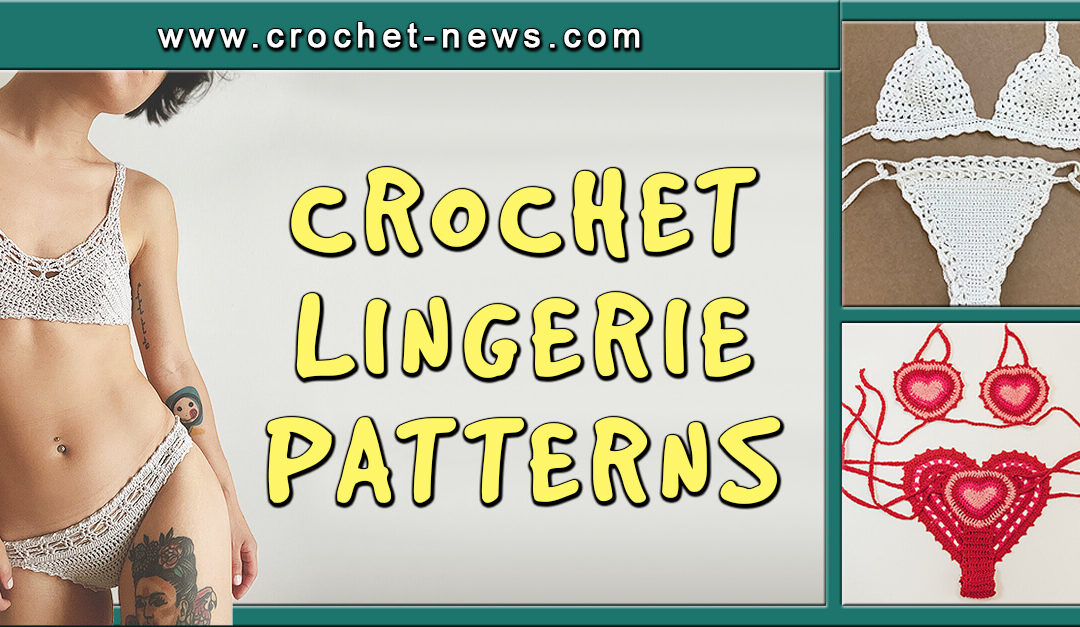Every crochet pattern requires yarn and a crochet hook. A crochet hook is an important tool that is used to pull yarn through loops. Without a crochet hook, you cannot work on a crochet pattern. Unlike knitting, which requires 2 or more needles, crochet only requires 1 hook.
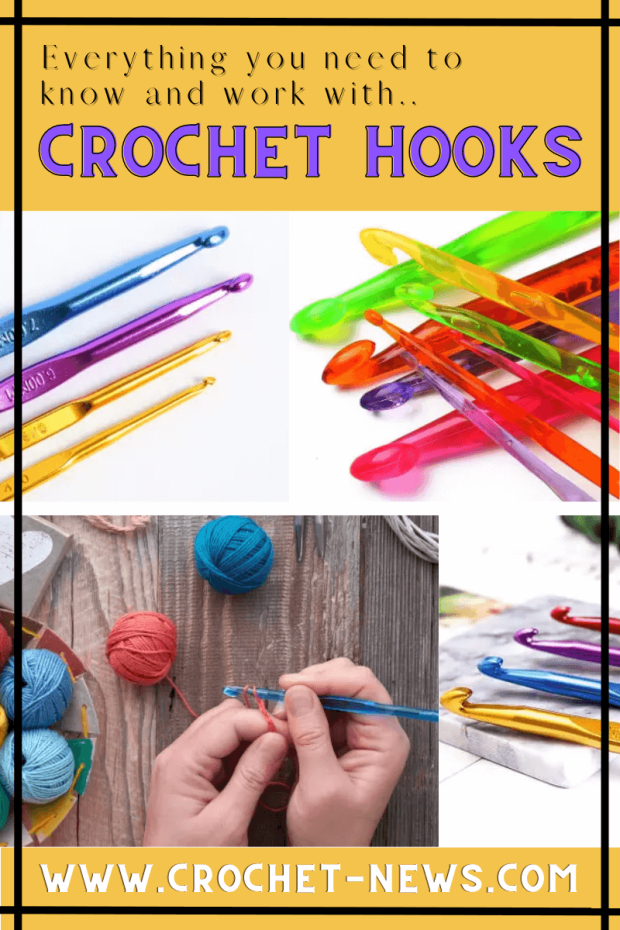
What are the Styles of Crochet Hooks?
There are two main styles of crochet hooks. They are inline and tapered. They look similar; however, they have slight differences. These slight differences can alter your project. Most crocheters usually prefer one or the other. There is no right or wrong choice. It all comes down to preference.

- Inline Crochet Hooks
Inline hooks usually have pointy heads and deep mouths. The lip and shaft are in line with each other. Incline crochet hooks are great for creating tighter, uniform stitches.
Pros of Incline Crochet Hooks
o It is easier to create consistent, uniform stitches.
o The pointed head makes it easier to insert into stitches.
o You have better control over tension.
- Tapered Crochet Hook
Tapered hooks usually have rounded heads and smaller mouths. The throat of the shaft tapers and the lip and shaft are not in line with each other. Some crocheters like tapered hooks because yarn does not slip off as easily.
Pros of Tapered Crochet Hooks
o Yarn does not slip off as easily.
o Some crocheters say they can crochet quicker.
o May lessen wrist pain.
o The rounded head will not split the yarn as easily as a pointed head.
What are the Different Types of Crochet Hooks?
Unlike knitting needles, crochet only has a few types of hooks. They are:
- Traditional Crochet Hooks
Traditional crochet hooks do not have any special features. They come in inline and tapered styles.
- Tunisian Crochet Hooks
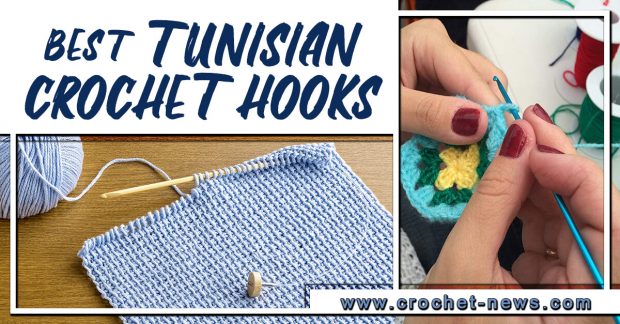
Tunisian crochet hooks are similar to knitting needles. They are longer than traditional crochet hooks and usually have a stopper on one end. When using Tunisian crochet hooks you keep your stitches on the hook.
This process is similar to knitting. These types of hooks are only used for projects that use the Tunisian stitch method. For Tunisian Crochet stitches, just click here.
- Ergonomic Crochet Hooks

Ergonomic crochet hooks are designed to be comfortable to use and reduce wrist pain. They have larger handles than traditional crochet hooks. They are available in both inline and tapered styles.

Knook crochet hooks have an eye near the end of the hook. The hooks are used to knit. Unlike traditional knitting, you only need 1 hook for a project. A nylon cord is threaded through the eye, and the stitches are slid onto the cord. Knook crochet hooks are intended for advanced crocheters that also know how to knit.
What Types of Materials are Crochet Hooks Made From?
You can find crochet hooks made from a wide variety of materials. You will find that different types of materials react differently to different types of yarn.
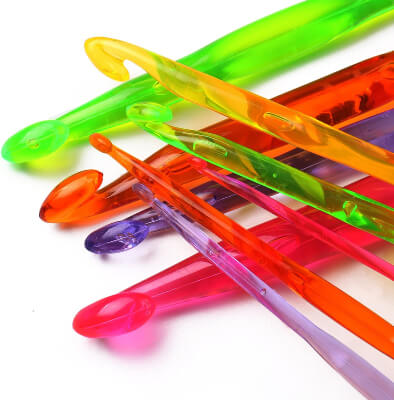
Plastic crochet hooks are very lightweight and smooth. They generally have very little friction. They are a great choice for crocheters that are fast. However, during the moulding process, plastic can have imperfections that can snag the yarn. If the hook is rough, you can usually use a nail file to smooth it out. Plastic can also break easily.
Plastic crochet hooks come in a wide variety of colours. They are inexpensive and easy to find in most craft stores. Most jumbo-sized crochet hooks are made of plastic.
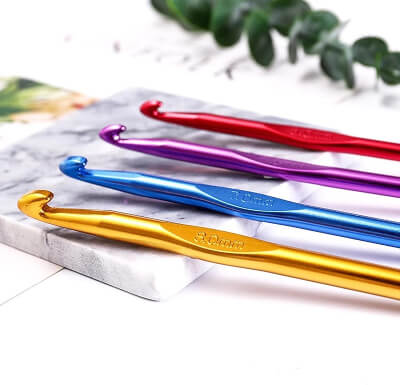
Aluminium crochet hooks are extremely durable and slippery. The slickness of the metal is great for fast crocheters. However, it can be an issue for beginners that have a problem with yarn slipping off the hook.
Aluminium crochet hooks come in a wide variety of fun colours. You can often find the hooks sold in colourful sets. Traditional aluminium hooks can cause wrist pain. However, you can find aluminium hooks with ergonomic handles.
- Steel Crochet Hooks
Steel crochet hooks are extremely strong and durable. It is almost impossible to break them when crocheting. Since they are strong and have very little give, they can be harder on the hands and wrists.
Steel crochet hooks are often used when working on a project that uses thread or lace weight yarn. It is the only material strong enough not to bend.
- Wood Crochet Hooks
Wood crochet hooks have a higher friction than other hooks. They are a great choice when working with slippery yarn. The friction helps prevent the yarn from sliding off the hook. When working with rougher yarns, wood can slow you down.
Wooden crochet hooks can be made from a wide variety of wood. The hooks are warm to the touch and feel nice in the hands. Wood is not as strong as other materials and can break under too much pressure.
- Bamboo Crochet Hooks
Bamboo crochet hooks are wood crochet hooks. However, unlike other wood hooks, the more you use them, the smoother they become.
- Ergonomic Crochet Hooks
Ergonomic crochet hooks can be made from any type of material. But instead of being straight, they have large handles that are easy to grip. These handles can make crocheting easier and reduce hand and wrist pain.
Crochet Hook Sizes

Just as with knitting needles, crochet hooks are measured in millimetres. They also have a corresponding letter and number combination. Although the letters and numbers should signify a certain size, they can vary by manufacturer. If in doubt, use a crochet hook gauge to measure the hook.
The size of the crochet hook will determine the size of your loops. The bigger the crochet hook, the larger your loops. A smaller hook will make smaller loops. When crocheting an airy fabric, you will want to work with a large hook.
When crocheting a dense fabric, you will want a smaller hook. Check out our full guide to crochet hook sizes.
Choosing the Best Crochet Hook
With so many types and sizes of crochet hooks to choose from, how do you know which one to choose? When picking your hook, take into consideration:
- Recommended Hook Size
Most crochet patterns will have a recommended hook and yarn size. These are only suggestions. You can use other sizes. However. If the pattern gives you a gauge, you need to use the recommended yarn and hook that will give you the correct gauge.
- Yarn Size
When you purchase yarn, you will notice that the packaging will have a hook size suggestion. The suggested hook size will create a solid piece of fabric. If the project you are working on has loose stitches, you will want to use a larger hook. If the pattern has tight stitches, such as amigurumi, you will need a smaller hook.
- Comfort
Crochet hooks come in a variety of materials. Try out several types of hooks to see which ones you are most comfortable using. If you are uncomfortable while you are crocheting, you will have a hard time completing your project.
How Do You Hold a Crochet Hook?
There are 2 popular ways you can hold your crochet hook. You can hold it like a pencil or a knife. Simply choose the way that is most comfortable for you.
- Pencil Grip

The pencil grip is when you hold your crochet hook like a pencil. You use 3 fingers. Pinch the thumb rest using your thumb and pointer finger. Let the hook rest on your middle finger.
- Knife Grip
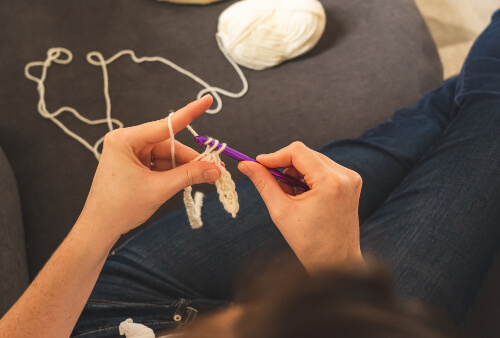
To hold your crochet using the knife grip, place your thumb on the thumb rest and wrap your other fingers around the shaft.
Anatomy of a Crochet Hook
When you look at a crochet hook, it may seem like a simple tool. But it actually has 6 distinct parts.
- Tip or Point
The Tip is also referred to as the point. It is part of the head. It is the pointed end of the crochet hook. This is the part of the hook that is inserted into stitches.
- Lip and Mouth
The lip and mouth are also parts of the head. The mouth holds the yarn and the lip prevents the yarn from falling off.
- Throat
The throat is the part of the hook that connects the head to the shaft. It can be inline or tapered.
- Shaft or Shank
The shaft is also referred to as the shank. It is the part of the crochet hook that is located between the throat and the thumb rest. You can use this area to hold loops. It can also be used when holding the hook.
- Thumb Rest or Grip
The thumb rest is also referred to as the grip. It is the section of the crochet hook that is flat. Some crochet hooks do not have a thumb rest. The thumb rest is located just above the middle of the hook. It is the ideal position for manipulating the hook.
- Handle
The handle is the remaining part of the crochet hook. It is the section of the hook that rests in the palm of your hand if you use the knife grip.
Best Brands of Crochet Hooks
There are several brands of crochet hooks on the market. But many crocheters prefer a select few. My favourite brands are Susan Bates, Boyle, and Knit Pro. All three companies make high quality crochet hooks that last.
We hope you enjoyed this guide to crochet hooks.
If you are new to crocheting, practice using a variety of crochet hooks. You will quickly learn what types of hooks are best for you. And if you experience pain while crocheting, consider using ergonomic crochet hooks. Ergonomic crochet hooks can make crocheting a lot more enjoyable.
If you are a new crocheter, we recommend you check out these articles: Crochet Stitches, Crochet abbreviations, Guide to Crochet Thread Sizes, Crochet Sets, Crochet Kits for Beginners, Crochet Patterns for Beginners and Blocking Boards help you with your crochet journey.

